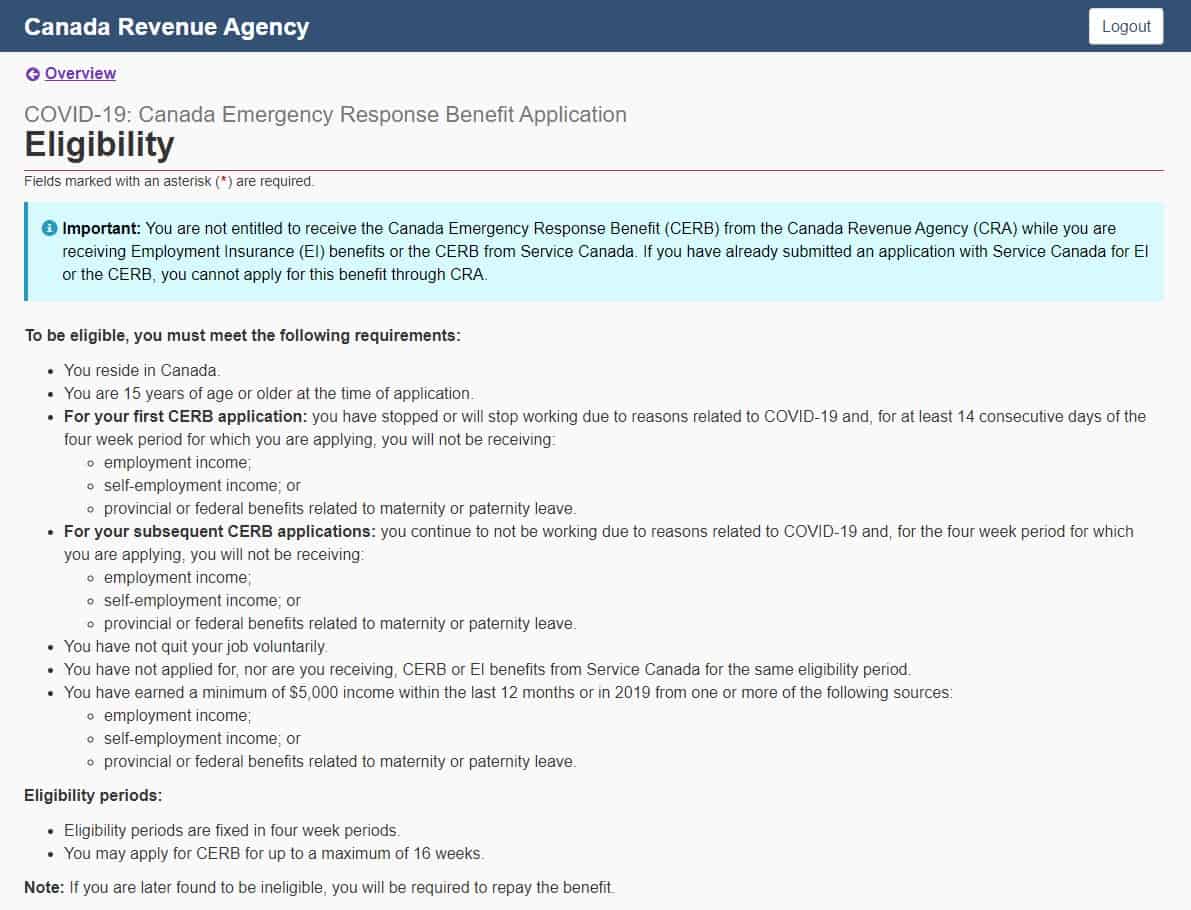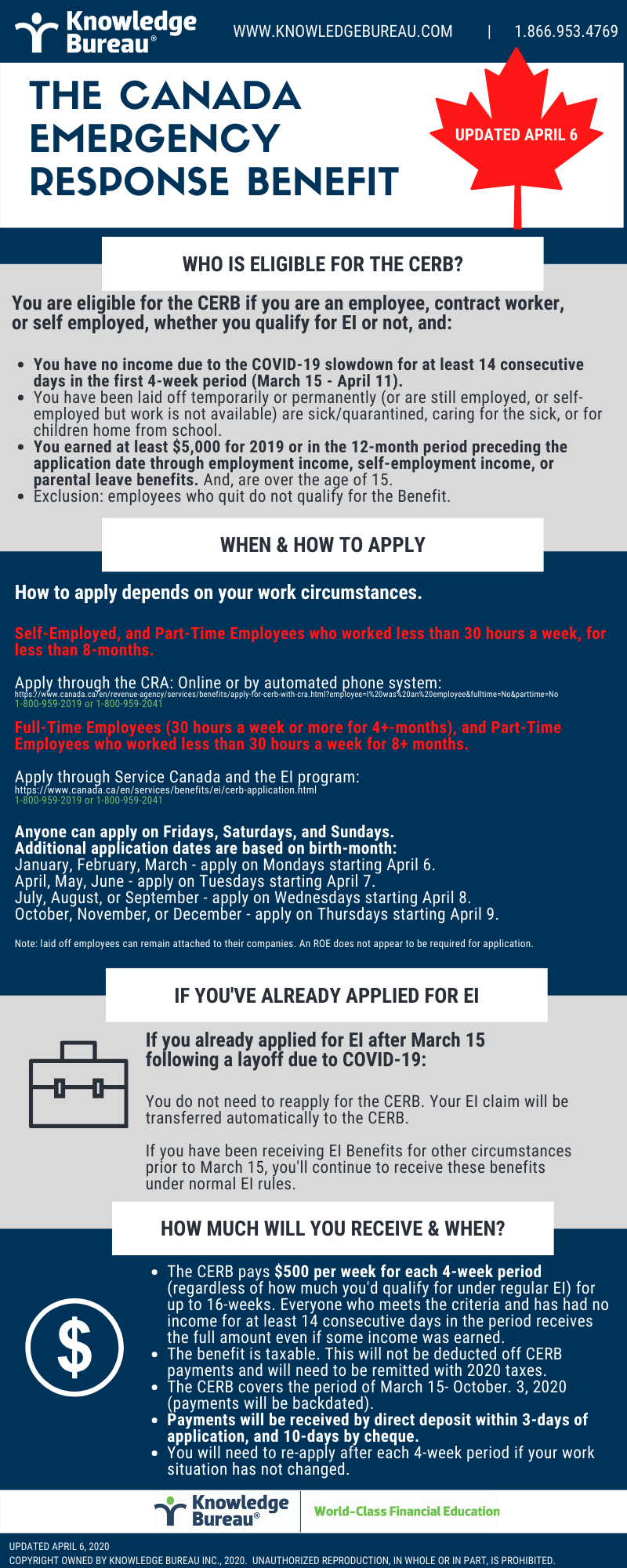- The Canada Employment Insurance Commission handles this program, and you can apply through your My Service Canada Account. To sign up, open your account and select “Employment Insurance for the Self Employed” on the home page. Then, follow the prompts to create your account. Calculating EI Premiums.
- As of September 27, 2020, there are some temporary changes to the EI program to help you access EI benefits. These changes will be in effect for 1 year. Go to EI benefits and leave to find the benefit type that applies to your situation. The following changes could apply to you.
- The Self-Employment Program does not provide start up financing. Individuals requiring a business loan to start their business are referred to the Community Futures Loans Officer and other financial institutions. The Self-Employment Program is flexible - however, program requirements must be met. Businesses must be full time, year-round operations.
If you are self-employed, when completing your personal Income Tax & Benefit Return, your tax situation is less straightforward than that of a typical salaried employee. Two areas where self-employed individuals differ from regular employees are in contributions to the Canada Pension Plan (CPP) and to Employment Insurance (EI).
Under the Employment Insurance Act, self-employed Canadians and permanent residents—those who work for themselves—are able to apply for EI special benefits if they are registered for access to the EI program.
Entrepreneurship of some kind has become a way of life for young workers today. If you are sole proprietor or partner of a business, a freelancer, an independent contractor or even doing Direct Sales as a side gig, CRA considers you to be Self-Employed.
CPP for Self-Employed
Everyone between the ages of 18 and 70 whose income is greater than $3,500 must contribute to the CPP. Regular workers contribute a particular percentage of their wages above $3,500, up to an annual maximum, while their employer contributes an equal amount. These rates change each year so to be aware of current rates, always check the CRA link.
Self-employed individuals are on the hook for both the employee and employer amounts (2 x the annual % to the annual maximum for self-employed persons). CPP contributions from self-employment are based on the net income of your business. To calculate your annual contributions at tax time, start with line 1 on 5000 – Schedule 8 (CPP Contributions on Self-Employment and Other Earnings and transfer the numbers as directed to your personal tax return. (Quebec residents must use the form specifically for them – 5005 – Schedule 8 – Quebec Pension Plan Contributions – QC only).

See this CRA link for more information on completing the form: Line 22200 – Deduction for CPP or QPP contributions on self-employment and other earnings.
Benefits:
Your CPP contribution pays into one of the major pillars of Canada’s retirement benefit system – the Canada Pension Plan.
When completing your tax return, you’ll receive a tax deduction for the “employer half” of the contribution plus a 15 percent federal tax credit for the “employee half” of the contribution.
Alternatives:
/cloudfront-us-east-1.images.arcpublishing.com/tgam/E4NQQWEQXZNBZMPZTCDLIVQOWU.JPG)
Self-employed individuals do have some flexibility on their CPP contributions depending on the way their business is structured. For example, a sole proprietor might consider incorporating, which gives them the option to pay themselves a salary or dividends.
Incorporated individuals can opt to pay themselves a lower salary and then take the rest of their income as dividends to reduce CPP premiums. Incorporated individuals can also participate in a pension plan. Sole proprietors don’t have that option.
Here’s an article from TurboTax that gives you the Pros and Cons of Incorporation.
EI for Self-Employed
While paying double the CPP contribution rate might seem excessive for some entrepreneurs, the good news is that self-employed workers do not have to pay EI premiums. That is unless they opt into the EI benefits for self-employedprogram which provides special benefits to the self-employed.
The six types of benefits available are as follows:
- Maternity Benefits – for people who are away from work because they’re pregnant or have recently given birth.
- Parental Benefits – for parents who are away from work to care for their newborn or newly adopted child.
- Sickness Benefits – for people who cannot work for medical reasons.
- Family Caregiver Benefit for Children – for people who provide care or support to a critically ill or injured person under 18.
- Family Caregiver Benefit for Adults – for people who provide care or support to a critically ill or injured person 18 or over.
- Compassionate Care Benefits – for people who provide care or support to a person who requires end‑of‑life care.
Each type of special benefit has its own maximum weekly rates of pay, as well as the maximum number of weeks you can collect the benefit. It’s important to know these maximums and you can find an easy to read chart outlining them here.
Self Employment Program Through Ei Benefit
Opting in means you’ll need to register for the Self-Employed EI Benefit Program, and you can do so through your My Service Canada Account. When self-employed persons opt into the EI program to access EI special benefits, they pay the same EI premium rate as employees pay.

EI premiums are paid when the self-employed worker files their annual Income Tax and Benefit Return using Schedule 13 (Employment Insurance Premiums on Self-Employment and Other Eligible Earnings). Unlike with the regular EI program, self-employed workers do not have to pay the employer’s portion of EI premiums.
Pitfalls:
There are some important factors to take into consideration before you decide as a self-employed worker to opt-in to the program:
- You must pay premiums for a full 12 months before you can collect any benefits. (And you need to have earned a minimum amount of self-employed earnings between January 1 and December 31 of the year before you apply).
- You can opt out of the Self-Employed EI Benefit program at the end of any tax year, only if you have never claimed benefits.
- For example: you cannot collect maternity benefits for the maximum number of weeks available, then decide you want to opt out of the program when you file your tax return for that year. You must contribute on self-employed earnings for as long as you are self-employed, if you have claimed benefits.
- Even after paying into the system for 12 months, if your business fails you will be ineligible for any benefits.
An extended leave might not be suitable for a business that relies on your time and effort to keep running.
Self Employment Program Ei
Alternatives:
Rather than opting-in to the EI program, you might consider investing the equivalent of the premiums instead. For example, if the maximum premium one could pay into the EI program was around $900.00, set that amount aside in a Tax Free Savings Account (TFSA) each year and watch your savings grow. This of course is not equivalent to the dollar amount of any special benefits you may receive, so you may want to add a little extra to that account if you are planning an event such as an adoption or pregnancy.
If you’re set on opting-in to the EI program as you are planning ahead for an event such as adoption or pregnancy, you should plan on taking at least two, if not three, full parental leaves for the program to pay off in your favour.
About Robb Engen
Robb Engen co-founded the award-winning personal finance blog Boomer & Echo in 2010 where he writes about saving, investing, and consumer advocacy. He also writes a monthly column for the Toronto Star. Robb lives in Lethbridge, Alta, with his wife and two children.
With more than 20 years’ experience helping Canadians file their taxes confidently and get all the money they deserve, TurboTax products, including TurboTax Free, are available at www.turbotax.ca.

Related Posts
The primary goal of the Self Employment Program is to help you a make well-thought-out, lasting transition from unemployment or underemployment to self-employment.
To participate in the Self Employment Program, you are required to meet with an employment counsellor at your local WorkBC Service Centre to find out if you are eligible.
Visit our page onEligibility Criteriato learn more.
Orientation sessions are held every 10 weeks. You will attend orientation online or in the community closest to you (Nelson, Creston or Nakusp).
Orientation is one day. 9:00 AM to 4:00 PM, with a one hour lunch break.
During the orientation, you will:
- learn how the Self-Employment program works including more detailed information about the program’s financial supports;
- complete an entrepreneurial self-assessment;
- receive and learn how to complete the Business Concept Application;
- learn how to conduct market research; and,
- receive research tools to help you with your Business Plan.
The Self Employment Committee, made up of volunteer entrepreneurs from the region, will review your Business Concept Application and determine if your business is suitable to move on to the Business Plan Development Phase.
If your Business Concept Application is approved, you will sign formal contracts. The ten week Business Plan Development Phase starts approximately two weeks later.
If eligible, you will receive living supports during the ten week Business Plan Development Phase. You may also be eligible for reimbursement of travel and child care expenses.
Self Employment Program Through Ei Learning
Approximately two weeks after contract signing, you will begin the ten-week Business Plan Development Phase.
During this time you will attend one to two workshops per week and work on your business plan.
Note: if needed, there is extra time and support available to individuals who have difficulty completing their business plan in the ten week time frame.
Business Plan Development Phase workshop topics:
- Market Research
- Managing business operations
- Financial Management: budgeting, cash flow, bookkeeping
- Obtaining financing
- Human Resources
- Sales, Marketing, and Social Media
Self Employment Program staff are also available for one-to-one business counselling and support while you research and develop your business plan.
At the end of the ten-week Business Plan Development Phase*, you will submit your business plan to the Self Employment Program Manager who will go over your complete business plan.

Self Employment Program Through Ei Application
The Executive Summary will be shared with the Self Employment Program Committee. A review will be conducted and if your business is approved, you will move forward to the launch of your business and continuation of the remaining 38 weeks of the Self Employment Program.
*Note: if needed, there is extra time and support available to individuals who have difficulty completing their business plan in the ten-week time frame.
Once your business plan has been approved, you will launch and run your business. For the remaining 38 weeks of the Self Employment Program, you will (if eligible) continue to receive living supports.
Ei Program Canada
You will also have funding to take workshops for free in theCommunity Futures Small Business Training Centre.
Self Employment Program staff are also available for one-to-one business counselling and support.
QUESTIONS?
Give us a call at (250) 352-1933 ext. 100, emailinfo@futures.bc.caor visit our office at201-514 Vernon Street in Nelson (above Canada Post). Note: during the COVID-19 pandemic, our office is closed to the general public.